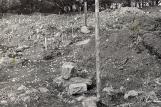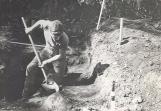1
WIlf and Elsie's close association with the Society of Jesus in Huronia led directly to requests for Wilf to undertake three separate but somewhat inter-related projects in Quebec. The first of these occured in the fall of 1952 when the Quebec Historical Society asked Wilf to hel examine a crypt in the basement of an old church in the heart of Quebec City. People were of the opinion that some currently unidentified skeletal remains that had been found elsewhere and deposited there years ago could possibly be those of Samuel de Champlain, whose final resting place had never been confirmed. Wilf somehow ascertained that none of the bones were those of Champlain. Wilf returned there in the fall of 1953 for brief fieldwork which uncovered a section of partially preserved stone wall that predated the church; he concluded the wall could possibly have been constructed in the Jesuit era of the early seventeenth century. For theseefforts, Wilf was granted an honorary membership in the Quebec Historical Society.
2
Immediately following his work in the church in September 1953, Wilf travelled to, "the old Jesuit house at Sillery, supposed by some to be the oldest house in Canada. A search was begun for the foundations of the stone fortifications that were said to have surrounded it. This project proved very gratifying as the foundations of the stone wall were soon discovered 18 inches to 2 feet below the surface of the soil. This was traced for 78 feet and the circular outline of a stone bastion was found on the north end" (Wilfrid Jury, 1953).In addition to the fortifications, Wilf's fieldwork uncovered evidence of the Jesuit house itself, other stone wall foundations, a well and an aqueduct. Sillery had been established as a mission by the Jesuits in 1637-1638, and it grew to include a church, hospital and residences. Jean de Brebeuf was stationed there for a brief interval in 1641-1642 and the Jesuits encouraged diverse groups of Natives, including Montagnais and Huron, to visit and/or stay there; Bruce Trigger of McGill University labelled Sillery the "first Indian reserve in Canada". Subsequent to Wilf's work the Quebec government and Society of Jesus commissioned others to conduct further archaeological investigations and archival research there and a small museum was opened on the site.3
Excavating Caughnawaga site, 4th Mission Site of Saint Francis Xaviercirca 1955-1957
South of Montreal, Quebec, Canada
 Credits:
Credits:Museum of Ontario Archaeology
4
In 1955 Wilf returned to Quebec at the request of the Society of Jesus: "In September we undertook to locate and examine the Jesuit Mission site of Kahnawake...situated on the south side of the St.Lawrence River opposite the City of Montreal. This particular site was the fourth of five sites occupied by the Indian settlement now known as Caeynnawaga. The fourth site was occupied between 1696 and 1719, during which years its inhabitants played a strategic part in the troubles of the times. This land will disappear shortly with the development of the St.Lawrence Seaway Project...During the two weeks' search we were successful in locating the site and finding sufficient evidence to warrant a complete excavation of this old Indian and Jesuit Mission, the Mission of St.Francis-Xavier, Caughnawaga" (Wilfrid Jury 1956:189 and UWO President's Report 1954-1955:43).5
Excavating at Caughnawaga sitecirca 1955-1957
South of Montreal, Quebec, Canada
 Credits:
Credits:Museum of Ontario Archaeology